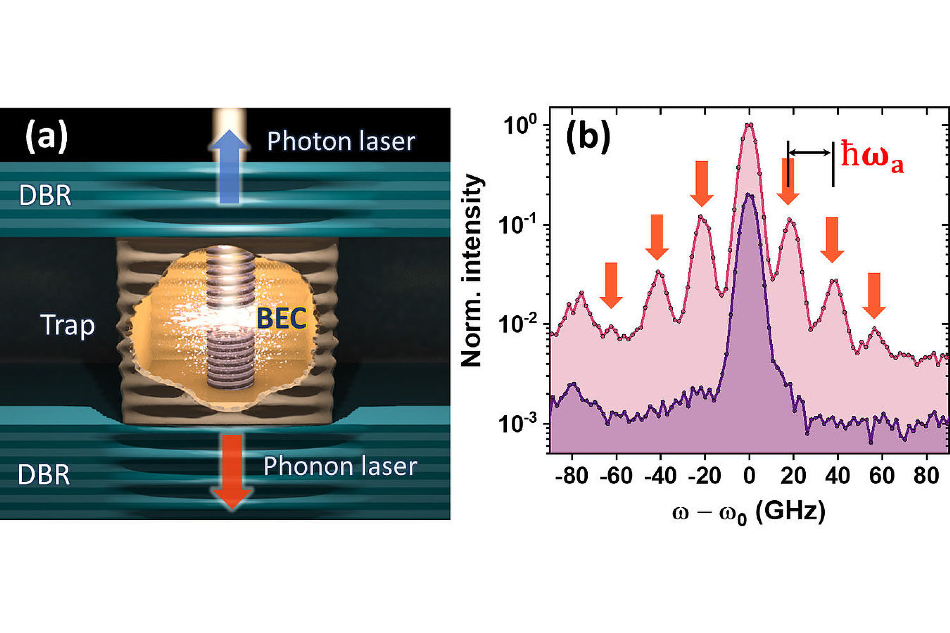Sep 14 2020
Lasing can be defined as the emission of a collimated beam of light that has a well-defined wavelength (color) and phase. This phenomenon results from a self-organization procedure, where a collection of centers generates identical light particles (photons) by synchronizing itself.
 (a) Polariton BEC and phonon lasing of a microstructured trap in a semiconductor microcavity. (b) BEC emission under low (the lower curve) and high (the upper curve) particle densities, displaying phonon sidebands separated by the phonon energy ℏω_a. PDI & Instituto Balseiro and Centro Atómico. Image Credit: Forschungsverbund Berlin.
(a) Polariton BEC and phonon lasing of a microstructured trap in a semiconductor microcavity. (b) BEC emission under low (the lower curve) and high (the upper curve) particle densities, displaying phonon sidebands separated by the phonon energy ℏω_a. PDI & Instituto Balseiro and Centro Atómico. Image Credit: Forschungsverbund Berlin.
An analogous self-organized synchronization phenomenon can also result in the emission of coherent vibrations—a phonon laser, in which phonon indicates, in analogy to photons, the quantum particles of sound.
Photon lasing was initially demonstrated around six decades ago and, coincidentally, six decades after its prediction by Albert Einstein. Such a stimulated emission of amplified light found an unparalleled number of technological and scientific applications in numerous areas.
Even though the idea of a “laser of sound” was prophesied almost simultaneously, only a few implementations have been reported to date and none has achieved technological maturity.
An association between scientists from Instituto Balseiro and Centro Atómico in Bariloche (Argentina) and Paul-Drude-Institut in Berlin (Germany) has now introduced a unique method to efficiently generate coherent vibrations in the tens of GHz range utilizing semiconductor structures.
Fascinatingly, this method used to produce coherent phonons is built on other predictions by Einstein—that of the 5th state of matter, a Bose-Einstein condensate (BEC) of coupled light-matter particles (polaritons).
As such, the polariton BEC is produced in a microstructured trap of a semiconductor microcavity containing electronic centers closely packed in-between the distributed Bragg reflectors (DBRs) developed to reflect the same energy light hω_C produced by the centers, as shown in the above image.
When the electronic states of the centers are optically excited by a beam of light with a varied energy hω_L, for which the DBR is transparent, they produce light particles, or photons, at the energy hω_C, which are back-reflected at the DBRs.
Subsequently, the centers reabsorb the photons again. The quick and repeating order of both emission and reabsorption events renders it unfeasible to differentiate whether the energy has been preserved in a photonic or electronic state.
One rather states that the mixing between the states generates a polariton, which is a new, light-matter particle.
Moreover, under a high particle density (and assisted by the spatial localization caused by the trap), the polaritons penetrate a self-organized state that is analogous to photons in a laser, in which all particles synchronize to discharge light with the same phase and energy—a polariton BEC laser.
The typical signature of the polariton BEC is a highly narrow spectral line demonstrated by the blue curve in the above image, which can be detected by quantifying the evanescent radiation exiting the microcavity.
An additional fascinating property of the utilized microcavity mirrors (DBRs) is the potential to reflect optical (light) and also mechanical vibrations (sound) inside a particular range of wavelengths.
As a result, a standard AlGaAs microcavity for photons in the near-infrared also limits quanta of vibrations—phonons with the energy hω_a that corresponds to the oscillation frequency ω_a/2p of around 20 GHz.
Since the photon reflection by the DBRs offers the feedback needed for the development of a polariton BEC, phonon reflection results in an accumulation of the phonon population and also leads to improved interaction of phonons with the polariton BEC.
But how does the interplay between phonons and polaritons take place? Similar to the air in a tire, a high density of condensed polaritons applies pressure on the microcavity mirrors, which can activate and maintain mechanical oscillations at the frequency of the limited phonons.
Such breathing oscillations alter the dimensions of the microcavity and thus act back on the polariton BEC. This coupled optomechanical interaction results in the coherent emission of sound that is above a critical polariton density.
A fingerprint of such a coherent emission of phonons is the self-pulsing of the BEC emission under constant excitation by a laser with the energy hω_L. This self-pulsing is detected by the emergence of powerful sidebands around the polariton BEC emission displaced by the multiples of the phonon energy hω_a.
Investigation of the amplitude of the sideband demonstrates that scores of monochromatic phonons populate the ensuing vibrational state and are discharged towards the substrate as a 20 GHz coherent phonon laser beam.
A main feature of the design is the stimulation of the phonons caused by an internal highly strong and monochromatic light emitter—the polariton BEC—which can be triggered optically and also electrically, as in a Vertical Cavity Surface Emitting Laser (VCSEL).
Moreover, higher phonon frequencies can be realized by suitably altering the microcavity design. Promising applications of the phonon laser comprise quantum emitters, the coherent control of light beams, gates in communication and quantum information devices, and also light-to-microwave bidirectional conversion in a very broad 20-300 GHz frequency range pertinent for upcoming network technologies.
Journal Reference:
Chafatinos, D. L., et al. (2020) Polariton-driven phonon laser. Nature Communications. doi.org/10.1038/s41467-020-18358-z